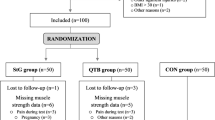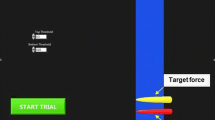Abstract
Purpose
To compare the active joint position sense (JPS), muscle strength, and knee functions in individuals who had anterior cruciate ligament (ACL) reconstruction with quadriceps tendon autograft, hamstring tendon autograft, tibialis anterior allograft and healthy individuals. It was hypothesized that when compared to an age and gender-matched healthy control group, subjects who were post-ACL reconstruction would display impaired active joint position sense, knee extensor and flexor strength symmetry and knee function at 1 year post-surgery. A secondary hypothesis was that differences would exist between the quadriceps tendon autograft, hamstring tendon autograft and tibialis anterior allograft groups.
Methods
Sixty-seven patients with ACL reconstruction and 20 healthy individuals were included. Active JPS reproduction was measured at 15°, 45° and 75° of knee flexion. International Knee Documentation Committee (IKDC) subjective score and one-leg hop test were used to assess the functional status of the patients.
Results
The JPS detection was different at the 15° target angle between groups (F3.86 = 24.56, p < 0.001). A significantly higher proportion of quadriceps tendon autograft group patients failed to identify the 15° active JPS assessment position compared to the other groups (p < 0.0001). The quadriceps index was lower in patients compared to healthy individuals (p < 0.001), while the hamstring index was similar (n.s.). The knee functional outcomes were similar between ACL reconstructed groups and healthy controls (n.s.).
Conclusion
Knee proprioception deficits and impaired muscle strength were evident among patients at a mean 13.5 months post-ACL reconstruction compared with healthy controls. Patients who underwent ACL reconstruction using a quadriceps tendon autograft may be more likely to actively over-estimate knee position near terminal extension. Physiotherapists may need to focus greater attention on terminal knee extension proprioceptive awareness among this patient group.
Level of evidence
III.
Similar content being viewed by others
References
Adams D, Logerstedt D, Hunter-Giordano A, Axe MJ, Snyder-Mackler L (2012) Current concepts for anterior cruciate ligament reconstruction: a criterion-based rehabilitation progression. J Orthop Sports Phys Ther 42(7):601–614
Alvira-Lechuz J, Espiau MR, Alvira-Lechuz E (2017) Treatment of the scar after arthroscopic surgery on a knee. J Bodyw Mov Ther 21(2):328–333
Anderson AF, Irrgang JJ, Kocher MS, Mann BJ, Harrast JJ (2006) International Knee Documentation Committee. The International Knee Documentation Committee Subjective Knee Evaluation Form: normative data. Am J Sports Med 34(1):128–135
Angoules AG, Mavrogenis AF, Dimitriou R, Karzis K, Drakoulakis E, Michos J et al (2011) Knee proprioception following ACL reconstruction; a prospective trial comparing hamstrings with bone-patellar tendon-bone autograft. Knee 18(2):76–82
Borsa PA, Lephart SM, Irrgang JJ, Safran MR, Fu FH (1997) The effects of joint position and direction of joint motion on proprioceptive sensibility in anterior cruciate ligament-deficient athletes. Am J Sports Med 25(3):336–340
Büyükafşar E, Başar S, Kanatli U (2019) Proprioception following the anterior cruciate ligament reconstruction with tibialis anterior tendon allograft. J Knee Surg. https://doi.org/10.1055/s-0039-1684010
Callaghan MJ, McCarthy CJ, Al-Omar A, Oldham JA (2000) The reproducibility of multi-joint isokinetic and isometric assessments in a healthy and patient population. Clin Biomech 15(9):678–683
Carter ND, Jenkinson TR, Wilson D, Jones DW, Torode AS (1997) Joint position sense and rehabilitation in the anterior cruciate ligament deficient knee. Br J Sports Med 31(3):209–212
Çelik D, Coşkunsu D, Kılıçoğlu Ö, Ergönül Ö, Irrgang JJ (2014) Translation and cross-cultural adaptation of the international knee documentation committee subjective knee form into Turkish. J Orthop Sports Phys Ther 44(11):899–909
Cheung SC, Allen CR, Gallo RA, Ma CB, Feeley BT (2012) Patients’ attitudes and factors in their selection of grafts for anterior cruciate ligament reconstruction. Knee 19(1):49–54
Clark JC, Rueff DE, Indelicato PA, Moser M (2009) Primary ACL reconstruction using allograft tissue. Clin Sports Med 28(2):223–244
DeAngelis JP, Fulkerson JP (2007) Quadriceps tendon—a reliable alternative for reconstruction of the anterior cruciate ligament. Clin Sports Med 26(4):587–596
Duchman KR, Lynch TS, Spindler KP (2017) Graft selection in anterior cruciate ligament surgery: who gets what and why? Clin Sports Med 36(1):25–33
Elmlinger BS, Nyland JA, Tillett ED (2006) Knee flexor function 2 years after anterior cruciate ligament reconstruction with semitendinosus-gracilis autografts. Arthroscopy 22(6):650–655
Foster TE, Wolfe BL, Ryan S, Silvestri L, Krall Kaye E (2010) Does the graft source really matter in the outcome of patients undergoing anterior cruciate ligament reconstruction? An evaluation of autograft versus allograft reconstruction results: a systematic review. Am J Sports Med 38(1):189–199
Fukunaga T, Johnson CD, Nicholas SJ, McHugh MP (2019) Muscle hypotrophy, not inhibition, is responsible for quadriceps weakness during rehabilitation after anterior cruciate ligament reconstruction. Knee Surg Sports Traumatol Arthrosc 27(2):573–579
Gandevia SC, Burke D (1992) Does the nervous system depend on kinesthetic information to control natural limb movements? Behav Brain Sci 15:614
Grob K, Manestar M, Filgueira L, Ackland T, Gilbey H, Kuster MS (2016) New insight in the architecture of the quadriceps tendon. J Exp Orthop 3(1):32
Harput G, Kilinc HE, Ozer H, Baltaci G, Mattacola CG (2015) Quadriceps and hamstring strength recovery during early neuromuscular rehabilitation after ACL hamstring-tendon autograft reconstruction. J Sport Rehabil 24(4):398–404
Iwasa J, Ochi M, Adachi N, Tobita M, Katsube K, Uchio Y (2000) Proprioceptive improvement in knees with anterior cruciate ligament reconstruction. Clin Orthop Relat Res 381:168–176
Kaeding CC, Aros B, Pedroza A, Pifel E, Amendola A, Andrish JT et al (2011) Allograft versus autograft anterior cruciate ligament reconstruction: predictors of failure from a MOON prospective longitudinal cohort. Sports Health 3(1):73–81
Kartus J, Movin T, Karlsson J (2001) Donor-site morbidity and anterior knee problems after anterior cruciate ligament reconstruction using autografts. Arthroscopy 17(9):971–980
Kistemaker DA, Van Soest AJK, Wong JD, Kurtzer I, Gribble PL (2012) Control of position and movement is simplified by combined muscle spindle and Golgi tendon organ feedback. J Neurophysiol 109(4):1126–1139
Kustos T, Balint L, Than P, Bárdos T (2004) Comparative study of autograft or allograft in primary anterior cruciate ligament reconstruction. Int Orthop 28(5):290–293
Landes S, Nyland J, Elmlinger B, Tillett E, Caborn D (2010) Knee flexor strength after ACL reconstruction: comparison between hamstring autograft, tibialis anterior allograft, and non-injured controls. Knee Surg Sports Traumatol Arthrosc 18(3):317–324
Lephart SM, Kocher MS, Harner CD, Fu FH (1993) Quadriceps strength and functional capacity after anterior cruciate ligament reconstruction: patellar tendon autograft versus allograft. Am J Sports Med 21(5):738–743
Logerstedt D, Di Stasi S, Grindem H, Lynch A, Eitzen I, Engebretsen L et al (2014) Self-reported knee function can identify athletes who fail return-to-activity criteria up to 1 year after anterior cruciate ligament reconstruction: a Delaware-Oslo ACL cohort study. J Orthop Sports Phys Ther 44(12):914–923
Middleton KK, Hamilton T, Irrgang JJ, Karlsson J, Harner CD, Fu FH (2014) Anatomic anterior cruciate ligament (ACL) reconstruction: a global perspective. Part 1. Knee Surg Sports Traumatol Arthrosc 22(7):1467–1482
Nagai T, Bates NA, Hewett TE, Schilaty ND (2018) Effects of localized vibration on knee joint position sense in individuals with anterior cruciate ligament reconstruction. Clin Biomech 55:40–44
Nyland J, Collis P, Huffstutler A, Sachdeva S, Spears JR, Greene J et al (2019) Quadriceps tendon autograft ACL reconstruction has less pivot shift laxity and lower failure rates than hamstring tendon autografts. Knee Surg Sports Traumatol Arthrosc. https://doi.org/10.1007/s00167-019-05720-y
Nyland J, Mattocks A, Kibbe S, Kalloub A, Greene JW, Caborn DNM (2016) Anterior cruciate ligament reconstruction, rehabilitation, and return to play: 2015 update. Open Access J Sports Med 7:21–32
Ozenci AM, Inanmaz E, Ozcanli H, Soyuncu Y, Samanci N, Dagseven T et al (2007) Proprioceptive comparison of allograft and autograft anterior cruciate ligament reconstructions. Knee Surg Sports Traumatol Arthrosc 15(12):1432–1437
Pennock AT, Johnson KP, Turk RD, Bastrom TP, Chambers HG, Boutelle KE, Edmonds EW (2019) Transphyseal anterior cruciate ligament reconstruction in the skeletally immature: quadriceps tendon autograft versus hamstring tendon autograft. Orthop J Sports Med 7(9):2325967119872450
Peterson RK, Shelton WR, Bomboy AL (2001) Allograft versus autograft patellar tendon anterior cruciate ligament reconstruction: a 5-year follow-up. Arthroscopy 17(1):9–13
Relph N, Herrington L (2016) Knee joint position sense ability in elite athletes who have returned to international level play following ACL reconstruction: a cross-sectional study. Knee 23(6):1029–1034
Scott SH, Loeb GE (1994) The computation of position sense from spindles in mono-and multiarticular muscles. J Neurosci 14(12):7529–7540
Sheean AJ, Musahl V, Slone HS, Xerogeanes JW, Milinkovic D, Fink C et al (2018) Quadriceps tendon autograft for arthroscopic knee ligament reconstruction: use it now, use it often. Br J Sports Med 52(11):698–701
van Eck CF, Schreiber VM, Mejia HA, Samuelsson K, van Dijk CN, Karlsson J et al (2010) “Anatomic” anterior cruciate ligament reconstruction: a systematic review of surgical techniques and reporting of surgical data. Arthroscopy 26(9):S2–S12
Victor J, Bellemans J, Witvrouw E, Govaers K, Fabry G (1997) Graft selection in anterior cruciate ligament reconstruction-prospective analysis of patellar tendon autografts compared with allografts. Int Orthop 21(2):93–97
Yoo S-H, Song E-K, Shin Y-R, Kim S-K, Seon J-K (2017) Comparison of clinical outcomes and second-look arthroscopic findings after ACL reconstruction using a hamstring autograft or a tibialis allograft. Knee Surg Sports Traumatol Arthrosc 25(4):1290–1297
Author information
Authors and Affiliations
Corresponding author
Ethics declarations
Conflict of interest
All authors have no conflicts of interest with respect to the data collected and procedures used within this study.
Funding
Authors declare that they have no sponsor in the study design, in the collection, analysis and interpretation of data; in writing of the manuscript; and in the decision to submit the manuscript for publication.
Ethical approval
The authors confirm this study meets the guidelines of the Declaration of Helsinki. Ethical approval for the study was received, and written informed consent was provided from all subjects (GO 18/504-41).
Additional information
Publisher's Note
Springer Nature remains neutral with regard to jurisdictional claims in published maps and institutional affiliations.
Rights and permissions
About this article
Cite this article
Guney-Deniz, H., Harput, G., Kaya, D. et al. Quadriceps tendon autograft ACL reconstructed subjects overshoot target knee extension angle during active proprioception testing. Knee Surg Sports Traumatol Arthrosc 28, 645–652 (2020). https://doi.org/10.1007/s00167-019-05795-7
Received:
Accepted:
Published:
Issue Date:
DOI: https://doi.org/10.1007/s00167-019-05795-7




